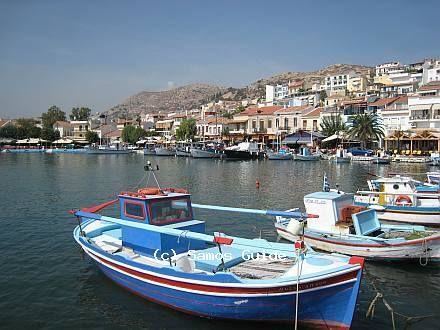Vehicle registration ΜΟ Regional unit Samos | Time zone EET (UTC+2) Local time Sunday 11:57 PM | |
 | ||
Weather 11°C, Wind SW at 2 km/h, 77% Humidity | ||
Pythagoreio (Greek: Πυθαγόρειο) is a small town and former municipality on the island of Samos, North Aegean, Greece. Since the 2011 local government reform, it is part of the municipality Samos, of which it is a municipal unit. Population 7,996 (2011). It is the largest municipal unit in land area on Samos, at 164.662 km2 (63.576 sq mi). It shares the island with the municipal units of Vathy, Karlovasi, and Marathokampos. The archaeological remains in the town, known collectively as Pythagoreion, has designated a joint UNESCO World Heritage Site with nearby Heraion.
Contents
Map of Pythagoreio 831 03, Greece
The seat of the municipality was the town of Pythagorio, formerly known as Tigani. The town was renamed in 1955 to honour the locally born mathematician and philosopher Pythagoras. The port of the town is considered to be the oldest man-made port of the Mediterranean Sea.
History
Pythagorio is built on the ancient city of Samos. Some ruins of the ancient city are today incorporated in modern houses of Pythagorio. The ancient city reached affluence around 530 B.C. under Polycrates tyrant. At that time Samos became a powerful nautical state. This power led to richness and prosperity, which is evident from great works of the period, such as the great aqueduct (part of it is the Tunnel of Eupalinos), temple of Heraion, and Samos harbour. Today many of these works can be seen in the modern town and nearby area. The ancient fortification also remains.
Samos was conquered by Persians and declined for a while. Samos flourished again for two short periods: First during the 3rd century under Ptolemy's rule (when lived Aristarchus), and second under Roman rule. The ruins of Roman period are visible today, about half a kilometre west of Pythagorio. The harbour of Samos remained important during Byzantine period. Ruins of the Byzantine period are visible in the area of Logothetis' Tower on the west side of the harbour.
Samos totally declined during Frangokratia, when the coastal settlements depopulated. In the later Ottoman period the centre of the island was Chora, built inland, 4 km northwest of Pythagorio. During Greek War of Independence the Samian Leader Lykourgos Logothetis built a tower in Pythagorio between 1824 and 1827. In 1831 Logothetis built a church near the tower. Between 1859 and 1866 the new harbour was built in the same place as the ancient harbour, after which the settlement started to develop. The name of new settlement was originally Tigani, a corruption to the Italian “Dogana” that means "customs", but in 1955 renamed to Pythagorio after the name of famous ancient Greek Mathematician and Philosopher from Samos Pythagoras.
Tourism and places of interest
Pythagorio is one of the most toured places of Samos since it has many archaeological sites as well as a big sandy beach. The most important sights in Pythagorio and the nearby area are:
